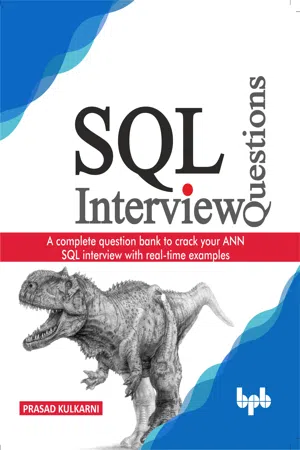Computer Science
SQL Value Functions
SQL Value Functions are built-in functions in SQL that return a single value based on the input value. These functions can be used to perform mathematical operations, manipulate strings, and perform date and time calculations. Some common SQL Value Functions include SUM, AVG, MAX, MIN, and COUNT.
Written by Perlego with AI-assistance
Related key terms
Related key terms
1 of 4
Related key terms
1 of 3
3 Key excerpts on "SQL Value Functions"
- eBook - ePub
SQL Interview Questions
A complete question bank to crack your ANN SQL interview with real-time examples
- Prasad Kulkarni(Author)
- 2019(Publication Date)
- BPB Publications(Publisher)
So, the objective of the chapter is to learn about the different SQL functions, including configuration function, conversion functions, cursor functions, date and time datatypes and functions, JSON functions, logical functions, mathematical functions, metadata functions, security functions, string functions, system functions, system statistical functions, text and image functions, and many more. We will also learn about the SQL wildcards and their usage with examples.So, let’s begin.SQL functions
Like other programming languages, SQL Server also has its own built-in functions, (function is a standard set of code that can be reused, and it helps us to remove code redundancy). SQL allows you to create/customize your own function. SQL built-in functions can be categorized as follows:Function category Description Configuration functions Functions of these categories are used to return information about the current configuration. Conversion functions Functions of these categories are used for casting and converting of support datatype. Cursor functions Functions of these categories are used to return cursor information. Aggregate functions Functions of these categories are used to perform calculation of a set of values Date and time datatypes and functions Functions related to date and time belong to this category JSON functions These functions are used to validate JSON data. Logical functions Functions of these categories are used to perform logical operations. Mathematical functions These functions are used to perform logical functions. Metadata functions The information about the database and database objects can be retrieved with these functions. Security functions Functions of these categories are used to fetch all the information related to users, and their roles can be retrieved using this function. String functions Functions of these categories are used to play with string and its different operations. System functions Functions of these categories are used to perform operations related to an instance of SQL Server. System statistical functions - eBook - ePub
Learn T-SQL From Scratch
An Easy-to-Follow Guide for Designing, Developing, and Deploying Databases in the SQL Server and Writing T-SQL Queries Efficiently
- Brahmanand Shukla(Author)
- 2021(Publication Date)
- BPB Publications(Publisher)
T-SQL is a strong tool. But just like other tools, it has no meaning unless the person using it knows how to use it. Built-in functions are one of such useful features of SQL Server which gives more out of just a plain raw data. You can play with your data and generate meaningful analytics out of it with the help of these functions. There are many such features that we’ll talk about gradually as we’ll move ahead.Structure
In this chapter, we will cover the following topics:- Aggregate functions
- String functions
- Numeric functions
- Date functions
Objective
After studying this chapter, you’ll be able to work with the various built-in functions ranging from aggregate functions used for aggregation, string functions used with the string’s values, the numeric function used with the numeric values, and date functions used with the date values. These string, numeric, and date values could be a static value or a constant, a variable, or a column. By the end of this chapter, you’ll be able to implement these built-in functions.Aggregate functions
Before we understand the aggregate functions, let’s first understand what a function is: A function is a block of organized and reusable code used to perform predefined actions and return a value.For example, if you want the addition of two values then you can create a function to accept two input parameters value 1 and value 2 and the function will perform value 1 + value 2 and return the result. Suppose you supplied value 1 as 100 and value 2 as 200 then the function will return the result as 100 + 200 = 300 - eBook - ePub
- Oswald Campesato(Author)
- 2022(Publication Date)
- Mercury Learning and Information(Publisher)
multiple-row functions that return one result per set of rows. Specifically, single-row functions in SQL will- manipulate data items
- accept arguments and return one value
- act on each row that is returned
- return one result per row
- may modify the data type
- can be nested
- accept arguments that can be a column or an expression
There two types of character functions: case-manipulation functions and character manipulation functions. Case manipulation functions in SQL include the following:SQL Character Functions
- LOWER
- UPPER
- INITCAP
- SUBSTRING
- LENGTH
- INSTR
- LPAD | RPAD
- TRIM
- REPLACE
Following this section are some one-line examples of some of the preceding built-in functions, where you need to replace my_table with a suitable table name and replace fname and phone_number with attributes from your table in your database:Remove leading spaces:SELECT LTRIM(fname) from my_table;Remove leading and trailing spaces:SELECT TRIM(fname) from my_table;Replace “-” with a space (“ ”):SELECT fname, REPLACE(phone_number, '-', ' ') as p_number FROM my_table;SQL supports built-in number functions, include the following functions:- ROUND
- TRUNC
- MOD
An example of the built-in truncate() function (which is different from the TRUNCATE keyword) is as follows:-- the value 12.345 is replaced with 12:SELECT TRUNCATE (average, 0) from my_table;SQL supports the following string operators that perform the concatenation of strings and partial matches of strings against meta characters:String Operators in SQL
Index pages curate the most relevant extracts from our library of academic textbooks. They’ve been created using an in-house natural language model (NLM), each adding context and meaning to key research topics.
Explore more topic indexes
Explore more topic indexes
1 of 6
Explore more topic indexes
1 of 4


